Who can say which comes first—a balanced body or a spacious mind? Science acknowledges that consciousness is not limited to the brain but is everywhere in the body. So the path to both steadiness and ease is consciously to unite body and mind. At the same time that yoga practice cultivates the physical stamina for meditation—that’s where we get the steadiness—the practice of meditative awareness brings about ease of mind and heart.
The notion of union is at the heart of both hatha yoga and meditation practice. Yoga, from the Sanskrit yuj, to yoke or bind, refers to the union of apparent opposites: masculine and feminine energies, small mind and big Mind, inner vision and outer awareness, steadiness and ease. We think of yoga as a balancing of mind and body. But where is the balance when your meditating body is so uncomfortable that instead of watching your thoughts arising and passing, your mind is totally focused on your aching back or knees?
As dharma practitioners, we know that everything changes, but sometimes emotional and physical disturbances—opinions, life experiences, digestive problems—lodge in the body, leading to blockages. Yoga practice consists of specific postures, or asanas—asana, in Sanskrit, means “seat” or “ground”—designed to ease the flow of breath, hormonal fluids, and blood, and to release toxic buildup resulting from bad diet, stress, and lack of movement. Asana practice is also a profound way to process feelings. As the body moves, so do emotions. Breathing in and breathing out, carving space with our arms and legs, turning ourselves upside down, letting go of thoughts and returning to the breath—yoga practice allows our entire body-mind to stay fluid.
The yoga program on these pages is specifically designed for meditators. These postures will strengthen your back and abdominal muscles, create flexibility in your shoulders and hips, and make space for your internal organs to function better, as well as improve cardiovascular function and expand your breathing capacity. The entire program takes just five minutes and can be done at both the beginning and end of your meditation. (In that way, it can serve as a bridge practice between sitting and moving mindfully through the world.) No warm-up or preparation is required. In fact, this is a warm-up. After a period of sitting, the program will get your prana—life force—moving again. Hold each pose for three to five breaths, except for the Cow and Cat poses.
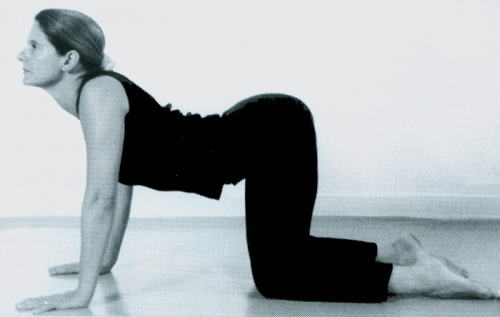
1. Cow Pose
Make sure your wrists are directly below your shoulders and your knees are directly below your hips. As you inhale, drop your belly and lift your sitting bones, chest, and face toward the sky. See if you can feel the front of your spine lengthening. Repeat this pose as many times as you want before moving on to Cat pose.
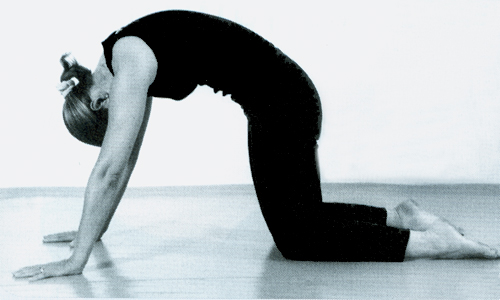
2. Cat Pose
As you exhale, tuck your head and tailbone under. Lift your belly up toward your spine, arching your back like a Halloween cat. Feel your back muscles soften outward. Repeat this pose as many times as you want. Cow and Cat create flexibility in your spine.
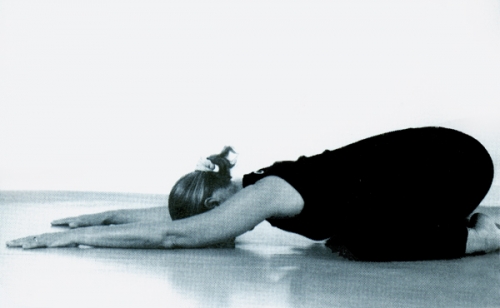
3. Child’s Pose
Separate your knees so that the space between them is wider than your hips. Press your pelvis back and drop your hips onto your heels. Rest your torso over your legs. Extend your arms in front of you. Tuck your head between them. This pose calms the brain, massages the abdominal and calf muscles, increases flexibility of the hips, and relieves lower back tension.
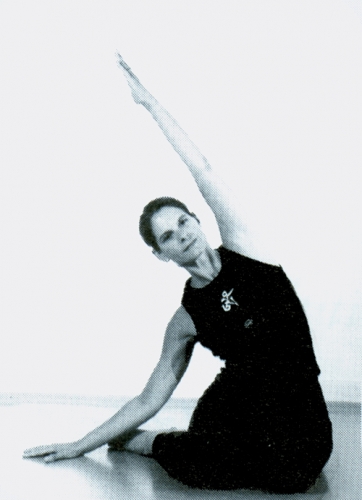
4. Side Stretch
Roll back up to a sitting position, taking time to feel each of the vertebrae as they stack on top of each other. Let your hips fall to the left. Lift your left arm and make a side bend to the right. Feel how your deep breathing opens up the accordion of your rib cage. If you feel as if you’re tipping over, put a cushion under your left hip. Come back to center. Now let your hips fall to the right and stretch your right side.
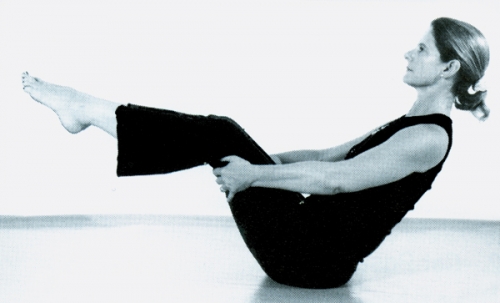
5. Boat Pose
Swing your legs around in front of you. Keeping your back straight, balance on your sitting bones, bend your knees, and raise your legs. You can hold onto your thighs or extend your arms straight out in front of you. Eventually, try straightening your legs and reaching your toes toward the sky. This is a major abdominal strengthener to help support your back for long hours—or even ten minutes—of sitting.
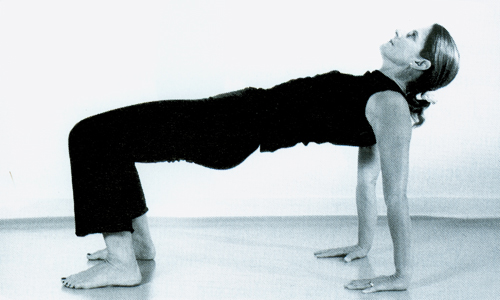
6. Tabletop Pose
With your knees directly over your ankles and your shoulders over your hands, press down into the earth with your hands and knees to lift your spine. Keep your back flat. Don’t squeeze your bum, but use your leg muscles to support you. This pose strengthens your back, wrists, arms, and legs, increases flexibility in the shoulder area, and lengthens the quadriceps, the large muscles on the front of the thighs.
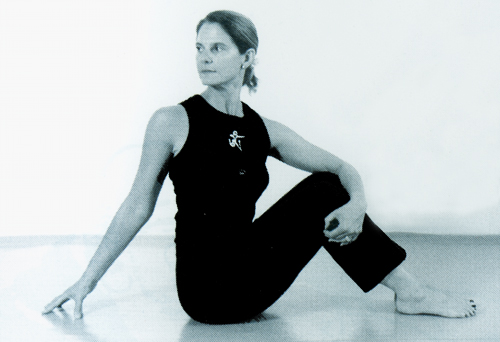
7. Twist
Sit up straight with a tall spine. On an exhale, twist your body to the right. Release, switch arms, and twist to the left. This is one of the most beneficial postures. It massages the internal organs, helping digestion, and stretches the back muscles, relieving backaches, neck aches, and headaches.
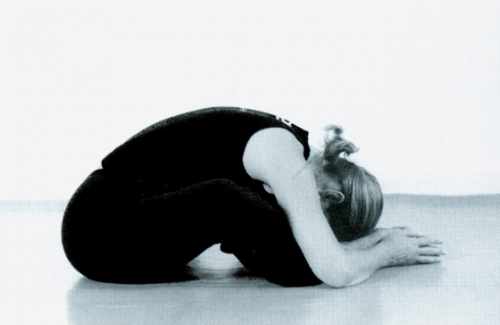
8. Star Pose
Bring your feet together, sole to sole, about two feet in front of you. As you exhale, slowly fold forward over your legs. Take your time, and don’t worry about how far you bend. It’s all about watching your body open up. If you keep paying careful attention as you do this pose, one day you’ll notice that you’re kissing your feet.
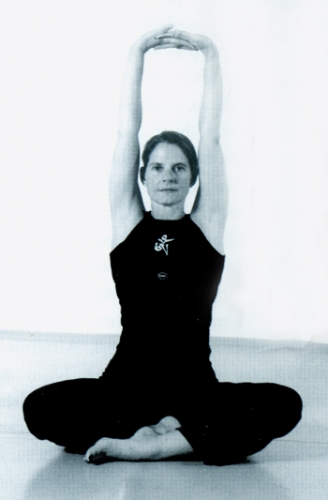
9. Shoulder Opener
Round up from Star pose and sit in a comfortable, cross-legged position. Use a cushion if you find it difficult to sit up tall on your sitting bones. It is important to keep your seat firmly grounded. As you reach the palms of your hands toward the sky, try to create length in your torso by lifting your ribs as your pelvis drops to connect with the earth
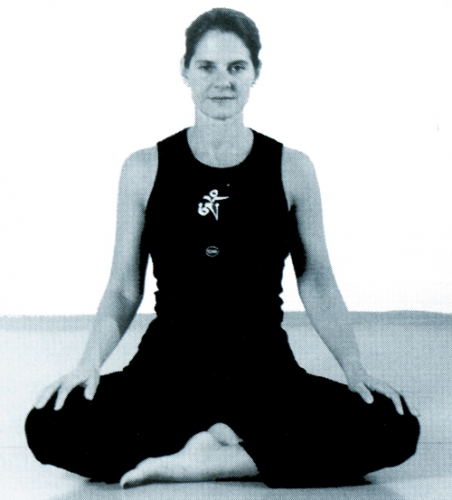
10. Sitting Tall
Unifying heaven and earth, reach up with the crown of your head as you release your arms and let them float down. Rest your hands on your knees.
Thank you for subscribing to Tricycle! As a nonprofit, we depend on readers like you to keep Buddhist teachings and practices widely available.